The Rough-legged Buzzard (Buteo lagopus) is a captivating raptor renowned for its Arctic prowess and distinctive characteristics.
Thriving in the northern reaches of North America, Europe, and Asia, these birds navigate the challenging landscapes of the Arctic tundra and subarctic regions.
Recognized for their unique adaptations to extreme cold, Rough-legged Buzzards boast feathered legs, providing insulation against frigid temperatures, a feature uncommon among other raptors.
Their plumage, displaying a mix of light and dark tones, serves both functional and aesthetic purposes. Remarkably, these birds are skilled hunters, preying on small mammals and birds with agile precision.
Their ability to hover in mid-air sets them apart, making them adept hunters in open terrains.
The Rough-legged Buzzard’s nomadic life, extensive migration routes, and vital role in Arctic ecosystems make it a captivating subject for ornithologists and bird enthusiasts alike. Stay sharp.
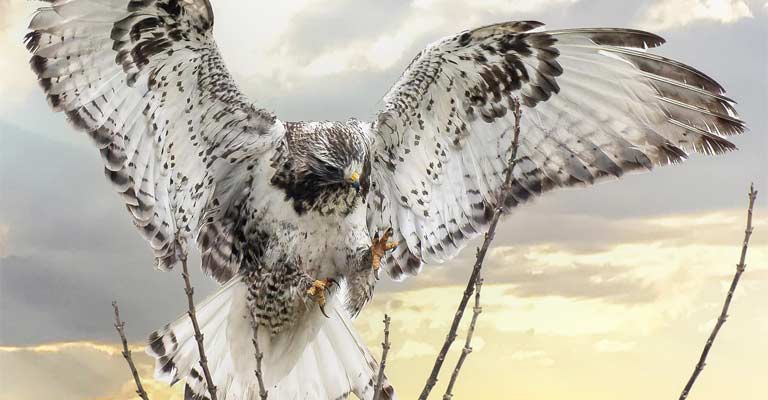
Identifying Characteristics of Rough-legged Buzzard
The Rough-legged Buzzard (Buteo lagopus) is a distinctive bird of prey characterized by several key features that make its identification relatively straightforward for keen birdwatchers.
Native to the Arctic tundra and subarctic regions, these majestic raptors exhibit unique traits that set them apart from other birds of prey. Here are some key characteristics to help identify the Rough-legged Buzzard:
Feathered Legs and Feet
One of the most distinguishing features of the Rough-legged Buzzard is its feathered legs and feet.
These adaptations serve as insulation against the harsh cold climates of its habitat.
The lower legs of this bird are covered in thick feathers down to the toes, a characteristic not commonly found in other buzzard species.
Light Coloration
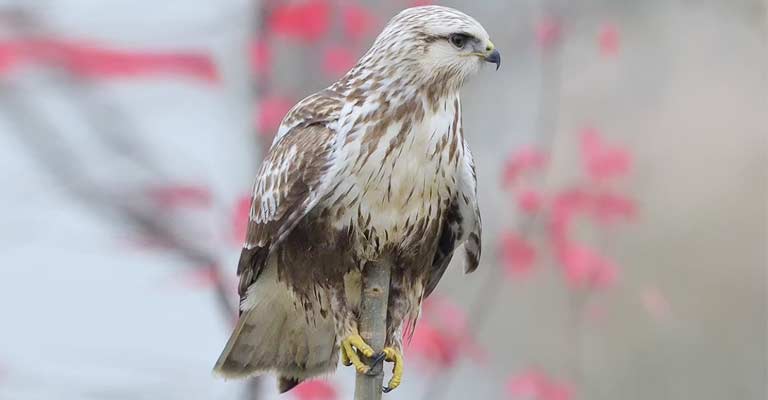
The overall plumage of the Rough-legged Buzzard is notable for its light coloration, particularly in male individuals.
They typically display a mix of white, brown, and black feathers, creating a mottled appearance.
This light coloration aids in camouflage against the snow-covered landscapes of their Arctic habitats.
Dark Belly Band
Another distinctive feature is the dark belly band that contrasts with the lighter plumage.
This band runs horizontally across the lower chest and belly. The contrast between the dark belly band and the light plumage is a key identifier when observing these birds in flight.
White Tail Base
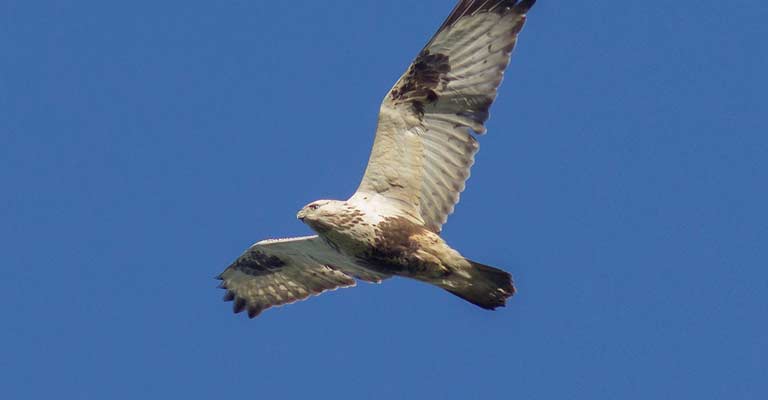
When in flight, the Rough-legged Buzzard reveals a white base to its tail, which is particularly noticeable against the dark terminal band.
This characteristic is useful for birdwatchers trying to distinguish it from other raptors, especially at a distance.
Broad Wingspan
The Rough-legged Buzzard has a broad wingspan, which aids in soaring and hovering over its hunting grounds.
Observing the bird’s flight pattern and wingspan can provide additional clues to its identity, as it differs from other buzzards with narrower wings.
Facial Disk and Beak
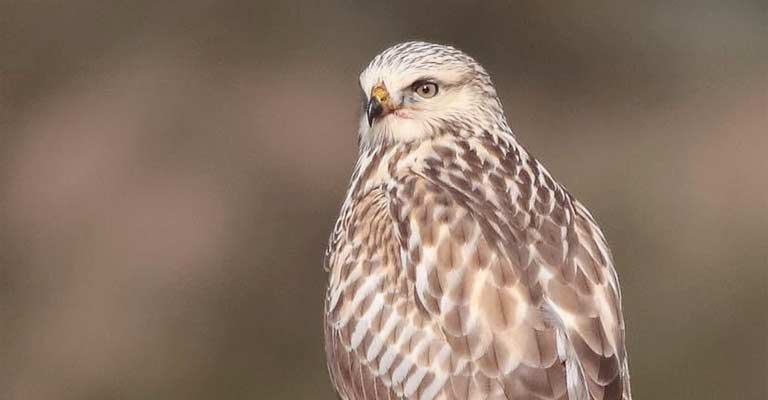
The facial disk of the Rough-legged Buzzard is less pronounced than that of some other raptors, such as owls, but it still contributes to its distinctive appearance.
The beak is hooked and designed for tearing into prey, typical of birds of prey.
Hovering Behavior
Unlike many other buzzards, Rough-legged Buzzards are known for their ability to hover in mid-air while hunting.
This behavior is facilitated by their broad wings and keen eyesight, making them effective hunters of small mammals, birds, and other prey.
Habitat and Geographic Range
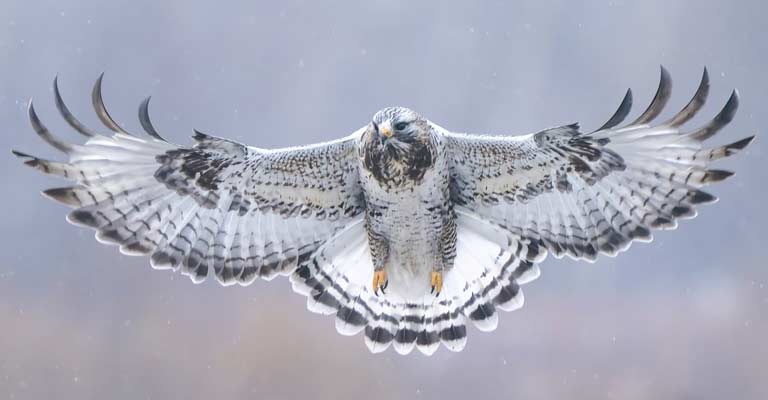
Knowing the habitat and geographic range of the Rough-legged Buzzard is crucial for identification. These birds are commonly found in Arctic and subarctic regions, where they breed and nest on cliffs.
During the winter months, they migrate to more southern latitudes, and birdwatchers may spot them in a variety of open habitats, including fields and marshes.
The Rough-legged Buzzard stands out among raptors due to its feathered legs, light coloration, dark belly band, white tail base, broad wingspan, facial disk, hovering behavior, and specific habitat preferences.
Observing these characteristics collectively will help birdwatchers confidently identify this fascinating bird of prey.
Taxonomy of Rough-legged Buzzard
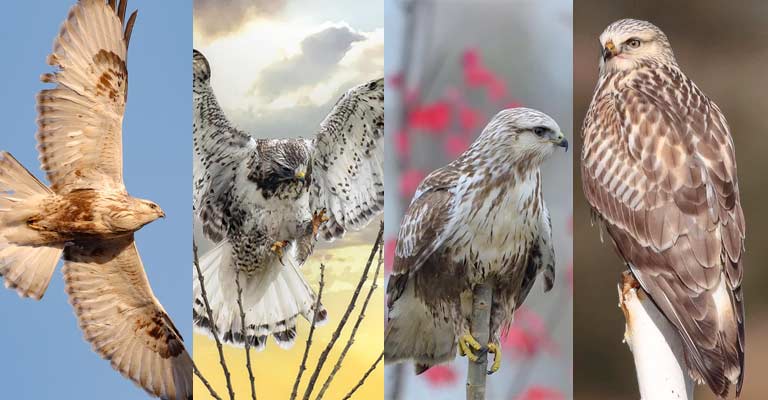
This classification highlights its place in the broader scheme of life, emphasizing its avian nature within the class Aves and its specific relationship with other birds of prey in the family Accipitridae.
| Taxonomic Level | Classification |
| Domain | Eukaryota |
| Kingdom | Animalia |
| Phylum | Chordata |
| Class | Aves |
| Order | Accipitriformes |
| Family | Accipitridae |
| Genus | Buteo |
| Species | Buteo lagopus |
The genus Buteo further specifies its characteristics and the species designation B. lagopus identifies this bird as the Rough-legged Buzzard within the Buteo genus.
The Rough-legged Buzzard (Buteo lagopus) exhibits fascinating geographical variations, resulting in distinct subspecies with unique characteristics.
Here are brief descriptions of the subspecies closely related to the Rough-legged Buzzard:
- Buteo lagopus sanctijohannis: Also known as the Saint John’s Rough-legged Buzzard, this subspecies is found in Greenland and nearby islands. It thrives in Arctic and subarctic habitats, displaying adaptations to the harsh conditions of its environment.
- Buteo lagopus menzbieri: The Menzbier’s Rough-legged Buzzard is native to northern Asia, particularly Siberia. It adapts to the taiga and tundra ecosystems, showcasing regional variations in plumage and behavior.
- Buteo lagopus lagopus: The nominate subspecies, Buteo lagopus lagopus, represents the Eurasian population of Rough-legged Buzzards. It inhabits the northern regions of Europe and Asia, with a distribution that extends into the Arctic.
- Buteo lagopus kamtschatkensis: The Kamchatka Rough-legged Buzzard is found in the Kamchatka Peninsula in eastern Russia. This subspecies is adapted to the diverse landscapes of the region, including mountains, tundra, and coastal areas.
- Buteo buteo vulpinus: While not a subspecies of the Rough-legged Buzzard, the Common Buzzard (Buteo buteo) includes a subspecies known as Buteo buteo vulpinus, commonly referred to as the Steppe Buzzard. It shares a genus with the Rough-legged Buzzard, emphasizing their taxonomic relationship.
These subspecies and related species showcase the adaptability of the Rough-legged Buzzard to various Arctic and subarctic environments.
Each variant has evolved specific traits to thrive in its distinct geographic range, contributing to the overall diversity and ecological resilience of the species.
Rough-legged Buzzard Life History
The Rough-legged Buzzard (Buteo lagopus), an inhabitant of the Arctic tundra and subarctic regions, boasts a captivating life history characterized by unique adaptations to survive in harsh climates.
From its feeding habits to nesting behavior, this bird of prey has evolved to thrive in cold environments. Understanding its life history provides insight into the remarkable strategies it employs for survival.
Food
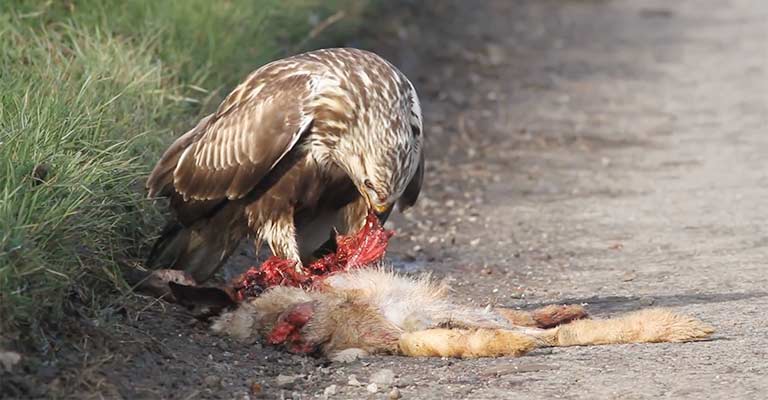
Rough-legged Buzzards are opportunistic hunters with a diverse diet. Their primary food sources include small mammals like voles, lemmings, and ground squirrels.
During the breeding season, they also target birds and their eggs, adding variety to their diet.
The buzzards use their keen eyesight to spot prey from high vantage points, and their feathered legs aid in maintaining warmth during long periods of perching and hunting in the Arctic cold.
Habitat
The preferred habitat of the Rough-legged Buzzard is the expansive Arctic tundra and subarctic landscapes.
They are well-adapted to open country, marshes, and coastal areas, where their hunting and nesting activities are facilitated.
As migratory birds, they exhibit a remarkable ability to adjust their habitat preferences, moving to more southern latitudes during the winter months.
Range Map
The Rough-legged Buzzard showcases a vast geographic range, breeding in the Arctic and subarctic regions of North America, Europe, and Asia.
Their range map extends across the tundra, with winter migration taking them to more temperate climates.
This migratory behavior is crucial for their survival, allowing them to access food sources year-round.
Nesting
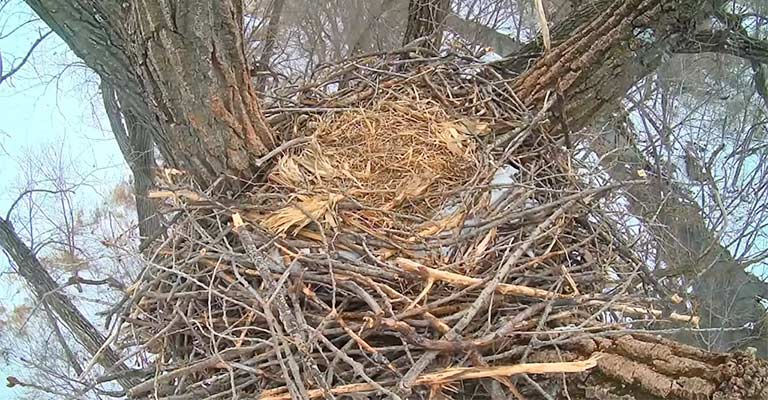
Nesting for Rough-legged Buzzards is a meticulous process. They often select elevated sites, such as cliffs or rock ledges, to build their nests.
The female is primarily responsible for constructing the nest using sticks, grass, and feathers. The well-insulated nest helps protect the eggs and chicks from the extreme Arctic temperatures.
| Nesting Details of Rough-legged Buzzard |
| Aspect | Details |
| Clutch Size | 2 to 4 eggs |
| Number of Broods | Typically one per breeding season |
| Egg Length | Approximately 2.3 to 2.8 inches (5.8 to 7.1 cm) |
| Egg Width | Approximately 1.8 to 2.1 inches (4.5 to 5.3 cm) |
| Incubation Period | Around 28 to 32 days |
| Nestling Period | Approximately 35 to 42 days |
| Egg Description | Pale bluish or greenish with light brown blotches |
| Nest Construction | Sticks, grass, feathers, lined with softer materials |
| Nest Location | Elevated sites, such as cliffs or rock ledges |
| Parental Involvement | Both parents participate in incubation and care |
| Feeding during Nesting | Both parents contribute to feeding the chicks |
| Nest Protection | Adults may display defensive behaviors to protect nest |
| Fledgling Independence | Chicks become independent after the nestling period |
| Reproductive Strategy | K-selected species with a focus on quality over quantity |
This table summarizes various aspects of the nesting details of Rough-legged Buzzards, providing key information about their reproductive behavior, clutch size, egg characteristics, incubation, nest construction, and parental care.
Breeding
Breeding season for Rough-legged Buzzards typically occurs in the spring and summer months. The female lays a clutch of eggs, usually ranging from two to four, and both parents take turns incubating them.
The chicks hatch after about a month, and the parents collaborate in feeding and protecting the offspring until they fledge and become independent.
Diseases
While the Rough-legged Buzzard does not face specific diseases unique to its species, it may be susceptible to general avian illnesses.
Common threats include bacterial infections, parasites, and environmental hazards. Monitoring the health of the population is crucial for conservation efforts.
Treatment
In captivity or rehabilitation scenarios, treatment for Rough-legged Buzzards follows standard avian veterinary practices.
This may involve addressing injuries, providing appropriate nutrition, and administering medication if necessary. The focus is on rehabilitation and release to ensure the bird’s successful return to the wild.
Conservation
Conservation efforts for Rough-legged Buzzards are imperative due to their vulnerability to environmental changes and human activities.
Protecting their breeding grounds, monitoring population health, and addressing potential threats such as habitat loss are crucial steps in ensuring the long-term survival of this species.
Collaborative international initiatives are essential to safeguard their extensive range and promote sustainable coexistence with human activities.
The life history of the Rough-legged Buzzard is a testament to its remarkable adaptations for survival in Arctic environments.
From hunting strategies to nesting behaviors, these birds play a vital role in the delicate balance of their ecosystems, underscoring the importance of conservation efforts to preserve their unique way of life.
10 Fun Facts About Rough-legged Buzzard
The Rough-legged Buzzard (Buteo lagopus) is a fascinating bird of prey, and exploring its characteristics reveals intriguing aspects of its biology and behavior. Here are 10 fun facts about the Rough-legged Buzzard:
- Arctic Nomad: The Rough-legged Buzzard is well adapted to extreme cold, with its feathered legs providing insulation against frigid Arctic temperatures. This adaptation allows it to thrive in some of the coldest regions on Earth.
- Migratory Marvel: These birds are long-distance migrants, covering vast distances between their Arctic breeding grounds and wintering areas in more temperate climates. Their journeys often span thousands of kilometers, showcasing remarkable navigational skills.
- Mouse-hunting Specialists: Rough-legged Buzzards are skilled hunters, and a significant portion of their diet consists of small mammals, particularly voles and lemmings. Their ability to hover makes them adept at pinpointing and capturing these elusive prey.
- Distinctive Plumage: While males typically exhibit a lighter coloration with a mix of white, brown, and black feathers, females have a darker and more uniform appearance. This sexual dimorphism is a notable feature of their plumage.
- Breeding Cliff-dwellers: During the breeding season, Rough-legged Buzzards often choose elevated nesting sites such as cliffs or rock ledges. This helps protect their nests from ground predators and provides a strategic vantage point for hunting.
- Hovering Hunters: Unlike many other raptors, Rough-legged Buzzards are capable of hovering in mid-air. This unique skill allows them to survey the ground below for potential prey and exhibits their versatility in hunting strategies.
- Diverse Vocalizations: These buzzards are not just visually striking; they also produce a variety of vocalizations. Their calls include high-pitched whistles, mewing sounds, and harsh cries, often used for communication between mates or during territorial disputes.
- Wintering in Open Habitats: While breeding in the Arctic, Rough-legged Buzzards move to more open habitats during the winter months. Fields, marshes, and coastal areas become their temporary homes, showcasing their adaptability to different environments.
- Conservation Concerns: The Rough-legged Buzzard faces threats such as habitat destruction, climate change, and human disturbance. Conservation efforts are crucial to safeguard their Arctic breeding grounds and migration routes.
- International Travelers: Rough-legged Buzzards have a broad distribution, breeding in North America, Europe, and Asia. Their migratory routes span international borders, emphasizing the need for collaborative conservation initiatives to ensure their well-being across diverse landscapes.
The Rough-legged Buzzard’s unique adaptations, hunting strategies, and international travels make it a captivating subject for bird enthusiasts and underscore the importance of conservation efforts to preserve this remarkable species.
Wrapping Up
In the vast landscapes of the Arctic and subarctic regions, the Rough-legged Buzzard stands as an avian marvel, showcasing remarkable adaptations, migratory feats, and an essential role in the delicate balance of its ecosystems.
From its feathered legs to its hovering prowess, each aspect of its life history reveals the tenacity and resilience required to thrive in extreme environments.
Conservation efforts become paramount, recognizing the challenges these birds face in the wake of habitat alterations and climate shifts.
As we delve into the intricacies of their nesting habits, migratory patterns, and distinctive behaviors, a profound appreciation emerges for the Rough-legged Buzzard, an aerial ambassador of the Arctic wilderness. Thank you so much.